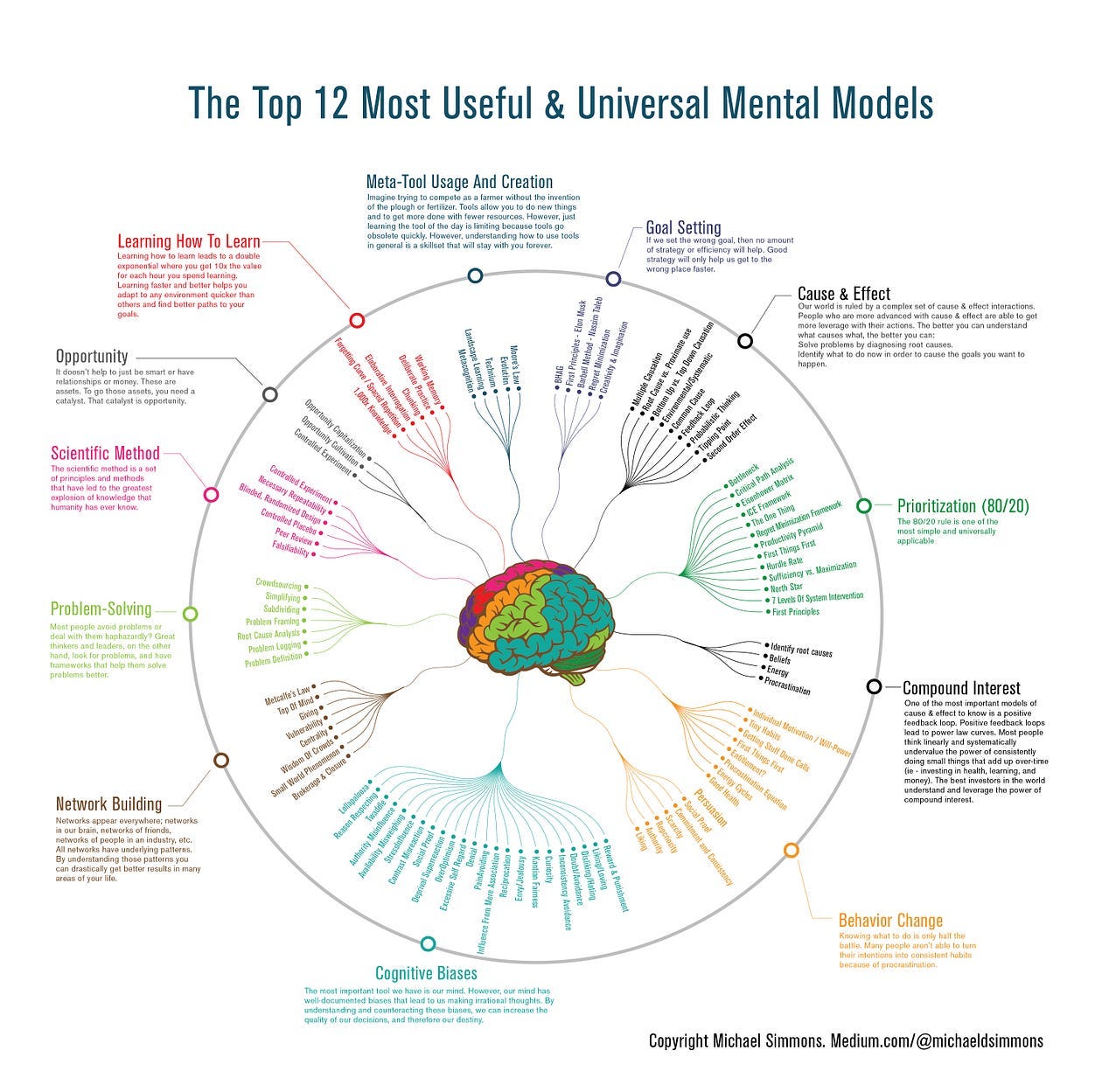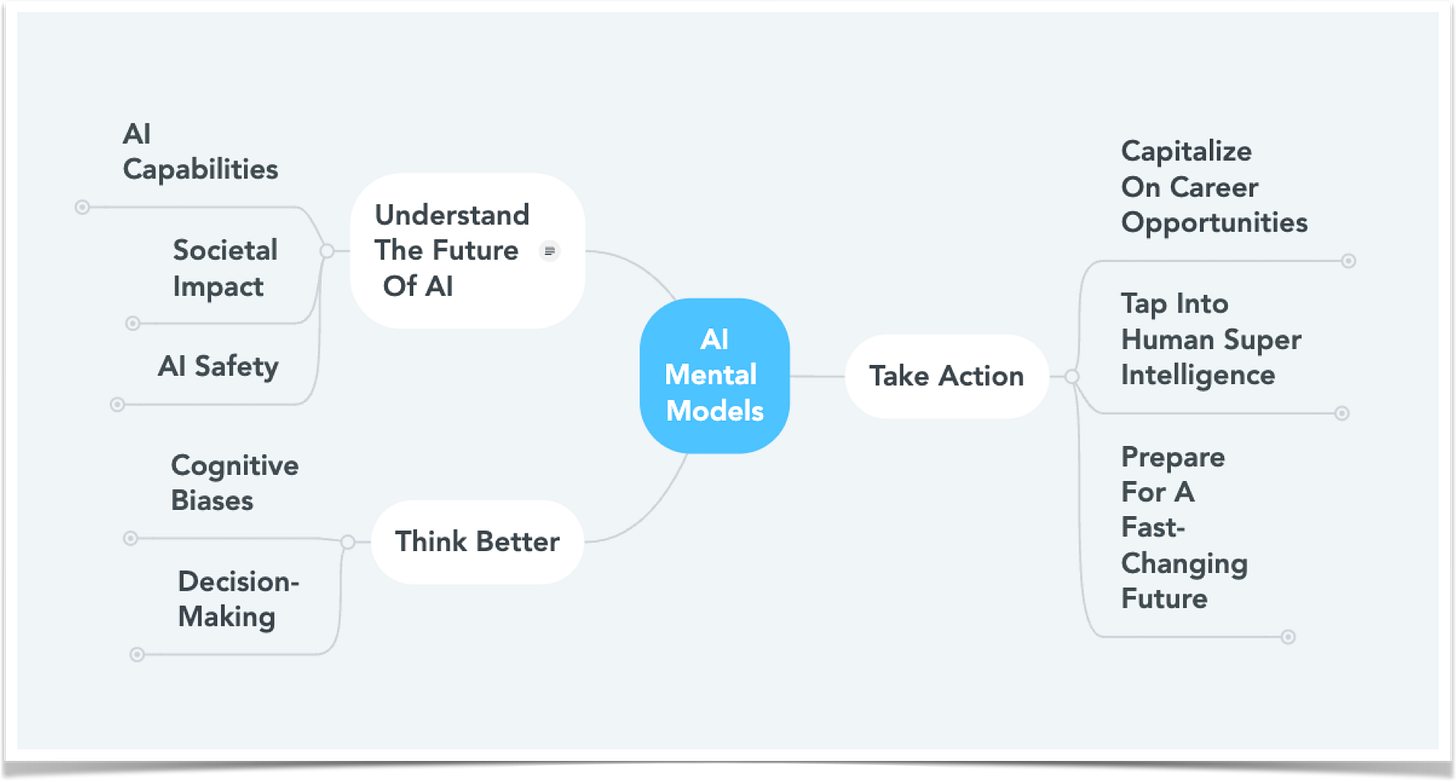This Is Exactly How To Train Yourself To Be Smarter About AI [TOP 100 AI MENTAL MODELS]
Author’s Note: Today is the day! This is the most important post in this newsletter since I launched it last July. I’ve spent more time on the research for this article than any other. I’m proud of it, and I hope you enjoy.
Over the last nine years, I’ve spent more time than anyone else in the world collecting and understanding the most useful and universal mental models (and then sharing them in my Mental Model Club). Mental models have fundamentally changed how I make decisions and experience life.
Because of the power of mental models, I’ve spent hundreds of hours collecting the 100 most important mental models related to AI over the last six months. To my knowledge, this is the first and most comprehensive map of AI mental models ever created.
If you’re wondering, “How can I go beyond surface-level AI news to learn about AI in order to prepare myself for the future of AI?” then this post is for you!
Quick Request: If you enjoy the mental model map, please forward it to a friend. It only takes 10 seconds. Making the map and esplainers has taken hundreds of hours.
What You Get In Today’s Post
Free members: Get access to the categorized list of mental models.
Paid members: In addition, get access to a chatbot I created to explain each of the mental models, suggest models for your particular situation, or to contextualize the news. I also provide the full prompt of the bot so you can customize it.
Mental Model Club members: Get access to a live version of a AI mental models class. More on this soon.
Today’s Post
AI will be the most important technology that humanity has ever created.
How we react to it NOW may be one of the most important career decisions we ever make. Now is the moment because we have the time and blue ocean to prepare financially, mentally, emotionally, and relationally.
To decide how we react, it’s critical that we deliberately learn about AI rather than making a blind, reflexive adoption or rejection decision.
This brings up the fundamental learning challenge we are all confronted with…
How Do We Best Learn About AI (Without Getting Lost in Noise, Bias, And Hype)
Most people simply ignore AI without seriously exploring it.
And honestly, this approach makes sense. AI is the worst it will ever be. There is nothing urgent pushing us to learn about it now. Focusing on what we’ve been doing in the past will give us the most immediate rewards.
But what we gain in the short term, we lose in spades in the long term. Just as it makes sense to buy low and sell high in markets, it makes sense to learn about AI before everyone else. Said differently, “Learn low. Act high.” Don’t start your learning while everyone else is acting.
Of those knowledge workers who do explore AI now, they often take one or both paths below:
Read AI news
Do AI prompting
While each of these paths is important, they are not enough to think strategically about what to do about AI in your life, career, and business.
It’s critical to understand the limitations of each path in order to move beyond them…
Path #1: Limits of reading the AI news
There are now dozens of podcasts, newsletters, blogs, Twitter accounts, and other experts that cover every update on AI, from demos, prompts, and tools to rumors, funding announcements, profiles, and predictions.
This news is important. And it is important to stay up-to-date to a certain degree.
At the same time, it’s easy to get lost in fake learning, where you think you’re learning, but, in actuality, you’re not learning nearly as much as you think.
The brutal reality is that within weeks and months, almost none of this news will matter:
Most new tools will not gain traction
Most predictions will turn out to be wrong
Most new companies will fail
New versions of AI will obsolete many of today’s prompts
Not only that, much of the news just isn’t practical now or is biased:
Demos are often highly edited and will take forever to turn into mainstream products
A lot of news ultimately isn’t relevant to day-to-day life and work
The news is biased to be interesting, which means it is overly optimistic or overly pessimistic
Path #2: Jump into prompting
Many jump right into prompting frontier chatbot models (eg, ChatGPT, Gemini, Claude) in order to understand what and how to prompt. Getting a basic proficiency is critical, and I highly recommend it.
But, at a certain point, you’re left with a decision of whether or not to go all-in and turn your into workflow into chained prompts.
The problem with going all in on prompting is a few-fold:
Obseletion Risk. New versions of frontier models will get better at creating prompts, which may make our old prompts obsolete.
Limits Of Today’s Models. While today’s frontier models are amazing, they are also seriously limited, which means our prompts often aren’t reliable or massively transformative yet. It can take hours of trouble-shooting prompts to get results that the next versions of AI will do easily out-of-the-box.
Energy-Intensive. It typically takes years to completely overhaul workflows. For example, it might take someone hundreds of tiny steps to do a knowledge workers job. And refining and testing each of those steps is time-intensive. Thus, starting a long workflow overhaul with a technology like AI that is changing so rapidly can be daunting and feel risky.
The Result Is AI No Man’s Land
While both reading AI news and doing basic prompting are key, at some point, they have diminishing returns, and many of us are just left waiting for GPT.
Thus, it’s easy to get stuck in a no man’s land where you believe that AI will be important in the future, but you’re not sure what to do now on a practical level that will actually end up paying off and not wasting time.
I personally can attest to feeling stuck in no man’s land.
Then, December happened.
In December, I found a way to get out of no man’s land…
There Is A Solution To AI No Man’s Land—Mental Models
I first became obsessed with mental models in 2015 when I read Poor Charlie’s Almanack, written by self-made billionaire investor and Warren Buffett’s longtime business partner, Charlie Munger.
In the book, Munger shares his life story and his #1 strategy for success: mental models. Mental models are frameworks that map the key cause-and-effect relationships across multiple domains. They are like wearing augmented reality glasses to see things others don’t and make smart, independent decisions.
It turns out that Munger had spent his whole life collecting the most important mental models:
“Developing the habit of mastering the multiple models which underlie reality is the best thing you can do.”
Charlie Munger, Warren Buffett’s Longtime Business Partner
As I started to explore mental models, I saw that many of the top innovators and leaders in history that I admired also swore by them. For example, Elon Musk, Ray Dalio, and Jeff Bezos have all publicly talked about the power of mental models.
What most excited me about this approach was the leverage. More specifically, the top mental models have a few amazing qualities:
Universal. They can be applied across domains. This is important so that we can bring our knowledge with us as we switch industries and professions throughout our careers.
Ever-Green. They will be relevant for the rest of our lives rather than getting outdated. This is important because it allows our knowledge to compound in value over time as we stack knowledge upon knowledge. As Einstein says, “Compound interest is the eighth wonder of the world.”
Rare & Valuable. Mental models can be used to make smart and unconventional decisions. Thus, rather than following the herd on major decisions, we can make independent, smart decisions.
In short, I saw that mental models would give me a foundational understanding of the world that would be more helpful than a college degree.
As I love to learn things more deeply by teaching them to others (see Explanation Effect), I started to share what I was learning.
In 2015, I wrote a Forbes article on the power of mental models titled How One Life Hack From A Self-Made Billionaire Leads To Exceptional Success.
In the following few years, I started collecting mental models. I finally shared my top models in late 2017 in the article This Is Exactly How You Should Train Yourself To Be Smarter [Infographic]. This article has been read by more than 342,000 people and introduced the following diagram…
In early 2018, Eben Pagan and I decided to collaborate to create the Mental Model Club. The premise was that we would introduce a new mastery manual every month on the most important mental models. The quote that inspired going deep on a small number of mental models was this Charlie Munger quote:
You may say, ‘My God, this [collecting mental models] is already getting way too tough.’ But, fortunately, it isn’t that tough — because 80 or 90 important models will carry about 90% of the freight in making you a worldly-wise person. And, of those, only a mere handful really carry very heavy freight.
—Charlie Munger
Over the last six years, we have released 50+ mastery manuals, each with a live class. You can try the club and get access to all of the manuals for just $1.
Looking back, making the leap of faith to go all in on mental models was one of the best decisions I’ve ever made. I constantly find myself re-using models I learned years ago in order to make better decisions, learn faster, and come up with my own Trademark Ideas.
This brings me to December 2023.
That’s when I realized I could more deeply understand the future of AI by collecting mental models in a few key areas…
11 Categories Of AI Mental Models Everyone Should Learn
My reasoning for choosing the categories above was as follows…
First, the most fundamental decision we need to make is about the future technical capabilities of AI. Our decision-making is completely different based on which of the following things we believe:
AI progress will continue to be exponential for years OR
AI progress will hit a wall and evolve very slowly
Sam Altman, CEO of OpenAI, puts these two possibilties in stark contrast with the following quote in a recent interview:
Interviewer: What are the characteristics of AI-first businesses that you think will survive GPT's advancement?
Sam Altman: The only framework that I have found that works for this is you. You can either build a business that bets against the next model being really good, or a model that bets on that happening and benefits from it happening.
After tons of research, I personally believe that the probability of AI continuing to grow exponentially for the next few years is very high. Therefore, I’m basing my decision-making on the scenario that it will continue while acknowledging that it isn’t guaranteed. For example, We could hit a large technical hurdle we can’t see right now. Or we might make so much progress that the government enforces an AI progress pause.
Second, we need to consider AI's societal impact. Fortunately, many researchers have spent their whole careers creating models about how technology impacts society. While it’s impossible for anyone to predict the exact impacts, these models provide us with broad scenarios to prepare for.
Third, once you consider how much our world could be upended in the near future, it’s important to stay rational. In periods of rapid change, many cognitive biases get triggered in us that we need to be aware of, and we need new frameworks for making decisions about an uncertain future.
Finally, we need to take action now. I dividing action-taking into three categories:
Capitalize on career opportunities. These models help us think about what skills, professions, industries, and other opportunities to identify, create, select, and pursue.
Tap into Human Super Intelligence. One of the things that makes humans unique is our ability to use tools to extend our own intelligence. These models help us reason about how to push the boundaries of our own potential with AI.
Prepare for a fast-changing future that is hard to fathom. While we don’t know the exact future, we can predict that it will be VUCA (volatile, uncertain, complex, and ambiguous). These models help us prepare for a VUCA world.
These categories are comprehensive but not exhaustive. To ship something now and keep things simple, I decided to hold off on collecting AI mental models related to:
Investing
Parenting
Romance
Friendship
Health
Hobbies
After identifying the most important mental model categories, I spent hundreds of hours collecting, understanding, and applying these models. Furthermore, I also did a few deep dives in the newsletter on AI mental models I found particularly important:
Ben Franklin, Thomas Edison, & Other Pioneers Teach A Critical Futurism Mental Model
Steve Jobs' Hockey Stick Rule Helps Predict The "Inevitable" Future Of AI
Elon Musk: "AI will probably be smarter than any single human next year.”
Finally, I made a fuller case for the power of AI mental models in Most People Think This Is A Smart Way To Learn AI, But It’s Actually Making You Dumber.
With that said, I’m finally ready to share the AI models I collected…
How To Use The List
This map is a v1. It does not include descriptions or links for all of the models yet.
If you’re curious about any of the models, I recommend going to the GPT that I created below to learn more about it (if you’re a paying subscriber). Alternatively, you can go to Google or Wikipedia to learn more.
After 9 years of learning about and teaching mental models, here’s my suggestion for how to master them:
Awareness. Get a basic understanding of all of the mental models.
Prioritize. Identify and go deeper into the most important mental models.
Apply. Think about all of the ways you can apply the model to your life.
Get Results. Apply the models until you get results.
Master. Use multiple models simultaneously and automatically.
But, for now, my #1 recommendation is simply to get acquainted with these models. While 100 models may sound like a lot, if you just learn one per day, you will get through all of them in three months.
100+ AI Mental Models That Will Help You Now In Your Life, Career, And Business (And Provide You With A Foundation To Navigate AI For Years)
UNDERSTAND THE FUTURE OF AI
Capabilities
Weak Signals
Lindy Effect
Wisdom Of Crowds / Collective Intelligence
Positive Feedback Loops
Bottlenecks
Exponential Growth
Moloch
Law Of Accelerating Returns / Moore’s Law
Exponential Curve
Double Exponential Function
S-Curves
Convergence Theory
Amara’s Law
Complexity Theory
Forecasting Error Bars
Content Fidelity Escalation
Anthropomorphic AI Evolution
Impact
Inflection Points
Scenario Planning
Hype Cycles
Second-Order Effects
Paradigm Shifts
Productivity Chain
Paradox Of Progress
Diffusion Of Innovations
Pace Layering
Socio-Technical Systems Theory
Moravec's Paradox
Polarization
Safety
Risk Of Ruin (Existential Risk)
The Control Problem
Orthogonality Thesis
Interpretability
Threshold Effects
Precautionary Principle
Dead Internet Theory
Tragedy Of The Anticommons
Red Teaming
Collective Action Problems
Moral Hazard
Recursive Self-Improvement
The Alignment Problem
Paperclip Maximizer
The Sorcerer's Apprentice Syndrome
Goodhart's Law
TAKE ACTION
Floor & Ceiling Skill Model
Comparative Advantage
Blue Ocean Strategy
Opportunity Space
Search
Long Tail
Value Chain
Adjacent Possible
3 Horizons Model
Jobs To Be Done
Design Thinking
Circle Of Competence
Value Chain
Inverse Risk Perception
ICE Model
Opportunity Cost
Return On Investment
Tap Into Human Super Intelligence
Cognitive Artifacts
Cognitive Offloading Framework
Extended Mind Theory
Compensation Theory
Skill-Biased Technological Change
Capitalize On Career Opportunities
Antifragility
Emotional Regulation
Kubler-Ross Grief Cycle
Terror Management Theory
Margin Of Safety
Black Swan Theory
Gray Swan Theory
Barbell Strategy
VUCA
Redundancy
Optionality
Goldilocks Zone Of Growth
5% Rule
Disruption Theory
Pre-Adaptation
Red Queen Effect
Network Brokerage
Power Of Weak Ties
Explore-Exploit Tradeoff
Negative Learning Transfer
THINK BETTER
Make Better Decisions
Probabilistic Thinking
Expected Value
First Principles
Inversion
Bayesian Thinking
Moonshot Thinking
Cognitive Biases
Paradigm blindness
Confirmation bias
Moving goalposts illusion
Fixed mindset about human potential
Status Quo Bias
Uncanny Valley
Availability Bias
Sunk Cost Fallacy
Group Think
In-Group vs Outgroup
Temporal Discounting
Status Quo Projection Bias
Temporal Displacement
Functional Fixedness
AI Mental Model Explainer Bot v1(Paid Members)
Bot Features
List and briefly explain each of the mental models
Do a deep-dive explanation of one mental model
Suggest models for your particular situation
Contextualize a major AI news announcement





